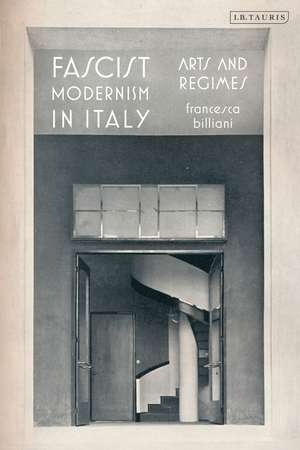Fascist Modernism in Italy: Arts and Regimes
Autor Francesca Billianien Limba Engleză Paperback – 22 mar 2023
| Toate formatele și edițiile | Preț | Express |
|---|---|---|
| Paperback (1) | 191.85 lei 6-8 săpt. | |
| Bloomsbury Publishing – 22 mar 2023 | 191.85 lei 6-8 săpt. | |
| Hardback (1) | 569.45 lei 6-8 săpt. | |
| Bloomsbury Publishing – 22 sep 2021 | 569.45 lei 6-8 săpt. |
Preț: 191.85 lei
Preț vechi: 249.64 lei
-23% Nou
Puncte Express: 288
Preț estimativ în valută:
36.71€ • 39.87$ • 30.84£
36.71€ • 39.87$ • 30.84£
Carte tipărită la comandă
Livrare economică 22 aprilie-06 mai
Preluare comenzi: 021 569.72.76
Specificații
ISBN-13: 9780755642076
ISBN-10: 0755642074
Pagini: 256
Ilustrații: 15 bw illus
Dimensiuni: 156 x 234 x 25 mm
Greutate: 0.36 kg
Editura: Bloomsbury Publishing
Colecția Bloomsbury Academic
Locul publicării:London, United Kingdom
ISBN-10: 0755642074
Pagini: 256
Ilustrații: 15 bw illus
Dimensiuni: 156 x 234 x 25 mm
Greutate: 0.36 kg
Editura: Bloomsbury Publishing
Colecția Bloomsbury Academic
Locul publicării:London, United Kingdom
Caracteristici
Cross-disciplinary - will appeal to a wide range of scholars from various disciplines including History, Art History, Art & Design, Architecture and Politics
Notă biografică
Francesca Billiani is Senior Lecturer at the University of Manchester where she teaches contemporary Italian literature and culture. Her research focuses on the Fascist period, censorship, literary journals, modernism, history of publishing, and intellectual history. She is the author of a monograph on the politics of translation in Italy (1903-1943), co-author of a monograph on architecture and the novel during the Fascist regime, editor of a collection of essays on translations and censorship, and co-editor of a volume on the Italian Gothic and Fantastic and of three special issues of scholarly journals.More resources relating to Francesca Billiani's research can be found here: http://dialecticsofmodernity.manchester.ac.uk/
Cuprins
PrologueParode1: Realism and Fascist State Art 2: The Fascist New Man/Woman and the Bourgeois Ulysses3: Architecture and the Arts in the Public Domain4: Art and Construction: Aesthetics and Politics in the Age of Totalitarianisms5: Aerofuturism: Journeys and ExplorationsExodusIndex
Recenzii
Francesca Billiani invites us to push the boundaries of a monolithic and simplistic view of State art to embrace the complexities of the relationship between arts and power with a courageous interdisciplinary approach. [.] the author convincingly demonstrates how the arts have contributed to the shaping of authoritarian practices [.], arguing for literature, visual arts, sculpture and architecture to be read not as distinctive and separate fields rather as parts of a complex cultural system.
Fascist Modernism in Italy is an impressive critical tour-de-force across numerous and varied objects of study: from journals, newsreels, public and private buildings, to paintings and even flying war machines. It will appeal not only to scholars interested in the osmosis between the arts and totalitarian power but also to anyone who seeks to enrich their knowledge of Italian 1930s visual art, literature and the debates informing them.
Meaningful in its contents and insightful in its analyses. Fascist Modernism narrates a paradoxical story in which innovative expressive potentials and censorship, art for the masses and underground and elite culture can coexist. A book to be read both for cultural enrichment and for pleasure.
Neither autonomous nor heteronomous to fascism, the arts functioned as myth-making machines and styled the regime as modern. In this remarkably cross-disciplinary research, by analysing literature, painting, sculpture and architecture in fascist Italy, Billiani untangles the knot between artistic production, totalitarian regimes and aesthetics, ultimately demonstrating how the arts shaped the very identity of the fascist regime.
Billiani assembled a holistic framework in which the price of exhibition tickets and the finer points of aesthetic theory appear as complementary facets of an emerging political order. The result is an impressive tour de force, a dialectical kaleidoscope that is both dazzling and informative. A must read for anyone interested in the mutual construction of art and authoritarian power, and the dynamics underpinning their re-negotiation.
Fascist Modernism in Italy is an impressive critical tour-de-force across numerous and varied objects of study: from journals, newsreels, public and private buildings, to paintings and even flying war machines. It will appeal not only to scholars interested in the osmosis between the arts and totalitarian power but also to anyone who seeks to enrich their knowledge of Italian 1930s visual art, literature and the debates informing them.
Meaningful in its contents and insightful in its analyses. Fascist Modernism narrates a paradoxical story in which innovative expressive potentials and censorship, art for the masses and underground and elite culture can coexist. A book to be read both for cultural enrichment and for pleasure.
Neither autonomous nor heteronomous to fascism, the arts functioned as myth-making machines and styled the regime as modern. In this remarkably cross-disciplinary research, by analysing literature, painting, sculpture and architecture in fascist Italy, Billiani untangles the knot between artistic production, totalitarian regimes and aesthetics, ultimately demonstrating how the arts shaped the very identity of the fascist regime.
Billiani assembled a holistic framework in which the price of exhibition tickets and the finer points of aesthetic theory appear as complementary facets of an emerging political order. The result is an impressive tour de force, a dialectical kaleidoscope that is both dazzling and informative. A must read for anyone interested in the mutual construction of art and authoritarian power, and the dynamics underpinning their re-negotiation.
